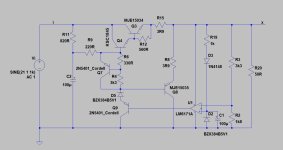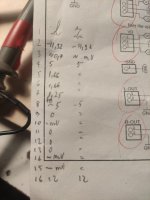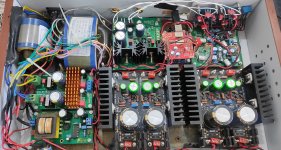Is it a worthwhile venture or has anyone tried headers for the I2S connections? I'm thinking of the ones Vunce mentioned in post #4022.
Regards,
Dan
What voltages do you measure directly on DAC chip pins regarding to GND when DAC is ON and music is playing? 🙂Ehm... Guys... I thinks I shot the two DAC Ic... Was wiring things in the new case...
What test can I do to tell if they're ok?
a second way is to use the pcb, if I am remembering the I/V resistor near the op amp has its layout in serie, put with the dac output. Put a 1 to 10 r here and see if you have AC across the resistor with your DVM at the lowest AC precision range ?
I built 2 of these. One I used the 21 dollar digikey wm8804 and the other I used an Ebay 2(wm8804) for 9 dollars(obviously chinese copy). I also have used a AK 4118 decoder board off Ebay for 50 dollars. I havent done any serious listening but they all sound the same to me so far. I only used coaxial connection and havent tested with USB.
Hello Miro,
I never posted here but I have built the AD1862 DAC based on your design and it works well.
Initially, I built it with output opamp stage on board and started of with LM6171 before upgrading to SS3601. Input board is JLsounds USB module, the first version. Power supplies include Salas Ultrabib for +/-5V and +/-12V for AD1862 and AMB sigma 11 and another supply for two independent 5V supplies for USB boards. I listened in this configuration for few years and was very happy with sound.
As part of upgrade, I have recently moved to new iteration of JLsounds USB module along with independent crystals. For the output stage, I have moved to FC CEN IV stage designed by EUVL and supported by Fran. I am letting in burn in as of now and will check it in my main system later on.
Thank you for your wonderful design and introducing us to AD1862 DAC.
Thanks
Balaji
I never posted here but I have built the AD1862 DAC based on your design and it works well.
Initially, I built it with output opamp stage on board and started of with LM6171 before upgrading to SS3601. Input board is JLsounds USB module, the first version. Power supplies include Salas Ultrabib for +/-5V and +/-12V for AD1862 and AMB sigma 11 and another supply for two independent 5V supplies for USB boards. I listened in this configuration for few years and was very happy with sound.
As part of upgrade, I have recently moved to new iteration of JLsounds USB module along with independent crystals. For the output stage, I have moved to FC CEN IV stage designed by EUVL and supported by Fran. I am letting in burn in as of now and will check it in my main system later on.
Thank you for your wonderful design and introducing us to AD1862 DAC.
Thanks
Balaji
Attachments
Thanks for sharing your build, I too am curious about your cen IV impression.
I have a somewhat similar setup, except for using the PCM63 board/IC. I recently went from the SS3601 to Burson V7v which, in my system and to my ears, offers a significant upgrade in terms of resolution and transparency. @Brijac gets credit for encouraging this upgrade 🙂
I use two Miro's PS2 for the DAC board and opamps (digital/analog separate). I recently borrowed a Salas uBib from another DAC to try it with the SS3601 and was quite surprised that it made the bass muddy and reduced the overall transparency (again, in my system and to my ears...). I upped the bias current and tried replacing the green Muses with Panasonic FRs, which helped, but went back to the Miro PS2. Just thought I would share this observation as it was unexpected given the great feedback the uBib gets. Maybe the Jung/Didden superreg will be next for the opamps, or the PSU2 mini with one for each channel.
Cheers,
Soren
I have a somewhat similar setup, except for using the PCM63 board/IC. I recently went from the SS3601 to Burson V7v which, in my system and to my ears, offers a significant upgrade in terms of resolution and transparency. @Brijac gets credit for encouraging this upgrade 🙂
I use two Miro's PS2 for the DAC board and opamps (digital/analog separate). I recently borrowed a Salas uBib from another DAC to try it with the SS3601 and was quite surprised that it made the bass muddy and reduced the overall transparency (again, in my system and to my ears...). I upped the bias current and tried replacing the green Muses with Panasonic FRs, which helped, but went back to the Miro PS2. Just thought I would share this observation as it was unexpected given the great feedback the uBib gets. Maybe the Jung/Didden superreg will be next for the opamps, or the PSU2 mini with one for each channel.
Cheers,
Soren
"I have a somewhat similar setup, except for using the PCM63 board/IC. I recently went from the SS3601 to Burson V7v which, in my system and to my ears, offers a significant upgrade in terms of resolution and transparency. @Brijac gets credit for encouraging this upgrade 🙂"
@Sorenm i was on the fence on this one...... looks like resistance is futile now 🤣 🤣
@Sorenm i was on the fence on this one...... looks like resistance is futile now 🤣 🤣
From all discrete regulators I ever tested in simulation, the best so far seems be the one from Pioneer PD-93. Very stable output under switching load, very stable output with dirty input ... everything a good DAC PSU should have 😊
Attachments
-
 Pioneer_PD-93_PSU_Transistors.jpg85 KB · Views: 170
Pioneer_PD-93_PSU_Transistors.jpg85 KB · Views: 170 -
 Pioneer_PD-93_PSU_Transistors_Sim1.jpg62.6 KB · Views: 164
Pioneer_PD-93_PSU_Transistors_Sim1.jpg62.6 KB · Views: 164 -
 Pioneer_PD-93_PSU_Transistors_Sim1_stable-output_detail.jpg75.1 KB · Views: 104
Pioneer_PD-93_PSU_Transistors_Sim1_stable-output_detail.jpg75.1 KB · Views: 104 -
 Pioneer_PD-93_PSU_Transistors_Sim1_Switching-Load.jpg109.4 KB · Views: 106
Pioneer_PD-93_PSU_Transistors_Sim1_Switching-Load.jpg109.4 KB · Views: 106 -
 Pioneer_PD-93_PSU_Transistors_Sim1_unstable-input_stable-output.jpg89.5 KB · Views: 164
Pioneer_PD-93_PSU_Transistors_Sim1_unstable-input_stable-output.jpg89.5 KB · Views: 164
Hello PJN,Interested in your impressions on the cen IV vs the ss3601.
I will let you know, I have to rely on my memory for the earlier sound and hence it is difficult to comment. I am burning in the output stage and will let you know after few days.
Thanks
Balaji
From all discrete regulators I ever tested in simulation, the best so far seems be the one from Pioneer PD-93.
Looks very much like the Jung / Didden. 🙂
Patrick
I don't have the skills/knowledge to appreciate the technical differences between the PD93 and Jung/Didden regulators, but would be curious how they would compare to Miro's PS2, in simulation or measurement. I guess an answer still wouldn't eliminate the need/urge to build and compare...
Don't forget that the final result depends as much on layout and implementation as simulation.From all discrete regulators I ever tested in simulation, the best so far seems be the one from Pioneer PD-93. Very stable output under switching load, very stable output with dirty input ... everything a good DAC PSU should have 😊
Did those you tested have remote sensing? If not, they will fall behind the Jung/Didden in practical use.
Look at these graphs: https://linearaudio.net/color-graphs-jack-waltons-regulator-article-vol-4
Jan
We have a version of Jan's which is also very stable.This one from Pioneer PD-93 is more stable ....
We even have a power amp version which is stable with 10,000uF caps.
That one can deliver at least 3A continuous at easy.
You just need to add some isolation between the opamp supply and the regulator output.
And of course choose the right opamp.
Patrick
Finally, a shunt regulator 🙂. You can do it even simpler with mosfets instead of bipolars.From all discrete regulators I ever tested in simulation, the best so far seems be the one from Pioneer PD-93. Very stable output under switching load, very stable output with dirty input ... everything a good DAC PSU should have 😊
- Home
- Source & Line
- Digital Line Level
- DAC AD1862: Almost THT, I2S input, NOS, R-2R

